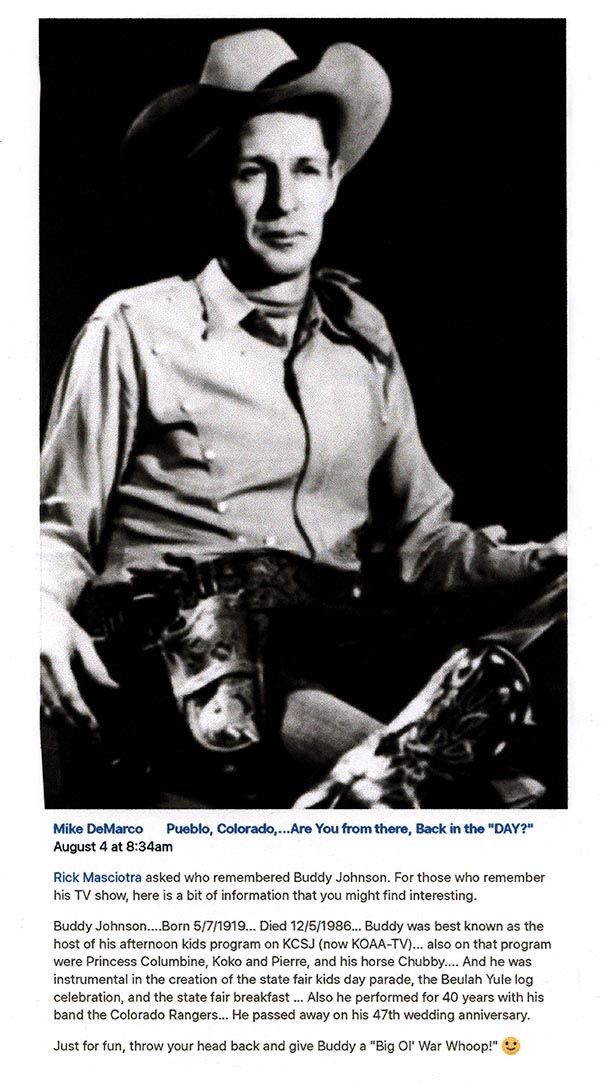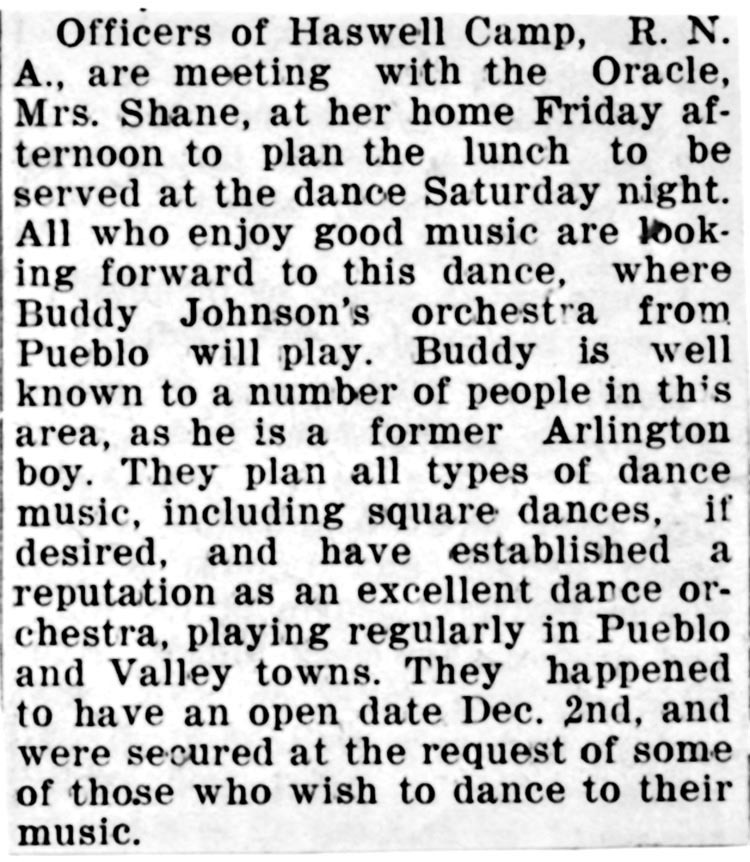A short history on the importance of Pueblo (and why its media was of such importance in Colorado).
In the arid West, Pueblo is unique in that it has lots of water (with two rivers) and mild, dry winters. So people have always lived here. The Spanish word ‘pueblo’ means ‘town' or ‘people’. Pueblo is where the people are living.
In 1779, Juan Bautista de Anza fought a major battle against the Commanche just south of here. In 1806, Zebulon Pike parleyed with a number of Grand Pawnee just east of here and he built the first American structure in what was the Louisiana Purchase here. When the explorer Stephen Long passed by in 1820 he found 600 Arapahoe tipis here.
In 1842, Pueblo was ‘founded’ by a dozen mountain men and was a competitor with Bent’s Fort for the Native American trade. “Pueblo" is listed on many charts as early as 1846, years before any other Colorado cities even existed. Except for 1854, when Pueblo experienced a Christmas time massacre, Pueblo probably had the largest non Native American, non Hispanic population of any settlement in the region until the 1859 gold rush when Denver surpassed it.
In the 1870’s, “the cowboy’s cowboy” Charles Goodnight, the man who invented the cattle drive and the chuck wagon had his ranch here. With its abundance of water, in 1881, the Colorado Fuel and Iron Company was formed to process the minerals from the nearby Rocky Mountains. The CF&I had its main plant in Pueblo, but also controlled many plants across the country and was owned by robber barons John D. Rockefeller and Jay Gould. It had dozens of "company towns" which it controlled across Colorado (like Crested Butte), Wyoming, New Mexico, Utah and Oklahoma. Early in the twentieth century, CF&I was so powerful, it listed on the New York Stock Exchange as one of the Dow Jones Industrials.
So for a century, Pueblo was the second most populous, prosperous and powerful city in Colorado, as was its media. Only in the mid 1960’s did the city of Colorado Springs surpass Pueblo as the state’s second most populous city after Denver.
For four decades Buddy Johnson was widely covered by the press - and he still is, below are some of these articles.

From the Pueblo Chieftain or Star-Journal, date unknown.
1953 Lamar Day celebration, Lamar publication unknown.
August 1, 1954, Pueblo Chieftain, Section D, Page 1.
Full page article about a Pueblo Chamber of Commerce get together in Beulah at Gayway.
Buddy and guitarist Dan Knezevich can be seen in the third image down on the left hand side of the page, while Buddy with mike can be seen interviewing a couple in the image bottom left.
Close Beulah friend and early dirt bike riding buddy E.M. Christmas and his wife are in the bottom center image, while Ray Traeber of Beulah is tending the fire at top right.
Pueblo had an incredibly positive feeling and spirit at this time. Like anything was possible.
August 11, 1956 , Colorado Rancher & Farmer, pages 22-23.
An interesting account of a Sunday Gayway Jamboree performance and the Rangers. Notable quote from Buddy, “Everyone has a right to express the music in his heart.”
1966 Kiowa County Press, Eads, Colorado.
1968 McClelland Orphanage Christmas party, publication and date unknown, probably the Pueblo Army Depot newsletter.
From the 1979 book: "Mace’s Hole, The Way It Was, To Beulah, The Way It Is (A comprehensive History of Beulah, Colorado)," published by the Beulah Historical Society, pages 179-80.
December 15, 1979. Large 3 page article in Pueblo Chieftain’s Panorama Magazine.
Extensive interview with Buddy (and Tillie) on his band, the TV and radio years and life in general.
“He was Southern Colorado’s Johnny Carson in a tassled buckskin coat interviewing visiting greats like Rex Allen, Gene Autry, Jim Reeves, Slim Whitman, Tex Ritter and Mexican star Tito Guizar in front of the studio camera.”
“Johnson said the pace nearly killed him, but said, “If it hadn’t been for her (his wife Tillie), I wouldn’t have been able to do it all.” Mrs. Johnson recalls, “It was a busy, busy time. We all loved it. We all enjoyed it.”
“I’ve done about everything in the book except bootleg. Anywhere that was big enough to dance in the south of Pueblo, we danced in it.”
“Johnson’s band background began with a drum his friend Vivian Aragon of Pueblo took out of his cellar in Rouse, Colo., back in 1946. Before that, Johnson, a native of Arlington, Colo., doodled a little with the piano and played high school trumpet.”
“Then it all boiled down to one approach. “I can’t say I felt any different than I had ever felt. I am the way I am. They either like me or they don’t.”
December 7, 1986, Pueblo Chieftain Article
When Dad died, he hadn't been on radio or TV for almost a quarter of a century. It's a testament to the impression he made on so many people's lives that even then, he was so well remembered.
December 8, 1986, Pueblo Chieftain Obituary
December 8, 1986, Denver Post Obituary
December 8, 1986, Rocky Mountain News Obituary
December 8, 1986, Colorado Springs Gazette Telegraph Obituary
Publication and date unknown, probably from the early 1990s.
1999 Pueblo Music Awards brochure
February 25, 2004, Pueblo Chieftain Obituary
"Tour Beulah’s Historic, Unusual and Forgotten Places" by Marilyn Klipfel Brehe, page 32.
October 2015, Pueblo Historical Ghost Walk brochure
The annual Fall Pueblo Ghost Walk portrays a number of significant Pueblo historical figures. Walkers travel from one end of the Historic Union Avenue District to the other. The group stops and hears each actor who portrays a historical figure.
The script for Buddy’s part was written by my good friend, writer and former Tamarack Productions partner, Joel Scherzer. It was acted by another good friend, former PCC teaching colleague and actor, Ken Thompson.
They rotate stories each year and it is done to benefit the Pueblo Domestic Violence Community Task Force. A video of Ken’s portrayal of Buddy can be seen on YouTube under "The Buddy Johnson Show."

August 4, 2017, even on Facebook
Notice the mention of the "War Whoop!"
October 2018, The Beulah Newspaper, Beulah, Colorado 2 pages.
“William A. “Buddy” Johnson grew up on Colorado’s eastern plains and Matilda “Tillie” (Trabucco) Johnson, who grew up in Canon City, knew Beulah was a good fit for the family. In time, the picturesque mountain backdrop would also become the spot (Gayway/Songbird) for memorable and historical music performances, all envisioned by a man who knew how to make indelible impressions.”
“Johnson’s wife, Tillie was in charge of the restaurant, and loved running it. He was the singer and drummer for his band and occasionally played the bass.”
“At the recent Beulah Reunion, many reminisced, and jotted down their fondest memories - Saturday Night dances came up most often. Buddy Johnson had everything to do with bringing the talent, and drawing the crowd to create a memorable ‘Heyday’ that is fondly recalled 56 years later!”
“An inductee of the Colorado Country Music Hall of Fame, Buddy Johnson’s career spanned a remarkable 41 years (1945-1986), a testimony to his talent, dedication, creativity and the ability to generate a darn good time.”
October 26, 2019. Pueblo Central High School, Class of 1969, 50th high school reunion, slide show by James Abell.
The opening slide in the "Our History . . . Youthful memories" presentation about the classmates early lives and shared experiences. Gary Dall 1969 Central High School graduate and MC asked: 1. Who here was on the Buddy Johnson show? To which most applauded or cheered, and 2. Who was Buddy's female sidekick? Answered by many in the room, "Princess Columbine!”
Buddy Johnson’s display at the Pueblo Heritage Museum in the Union Avenue Historic District.

Haswell or Eads, Colorado newspaper - an early date which is unknown.
I love how this early newspaper article lists Dad as “he is a former Arlington boy.”